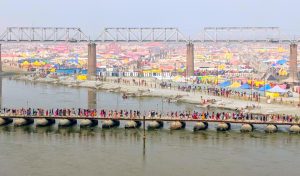With growing warnings of the cascading impacts of climate change in the Hindu Kush Himalayas, the region’s hydropower sector ought to take note.
Melting snow and retreating glaciers in a region, parts of which are warming up at three times the global average, will drastically change the seasonal flow of Asia’s major rivers. More intense floods and rainfalls and periods of prolonged drought are predicted and will wreak havoc for hydropower stations. In the longer term lack of water may mean dams are no longer viable.
The region has 500 GW of potential energy, and 550 projects underway are planned or are under construction in steep Himalayan valleys in China, India, Pakistan and Bhutan, according to ICIMOD’s new HIMAP report.
But there are unknown consequences for the rivers and incalculable potential for catastrophic hazards. These risks are strangely overlooked in the major new assessment of the impacts of climate change in the HKH region, carried out by leading scientists at ICIMOD.
The report calls for more water resources to be allocated to hydropower generation, by prioritising large scale projects and cross border infrastructure for regional trading of power through the grid.
The potential impacts on fragile ecosystems, river flow, downstream flood plains are mentioned, but framed as necessary trade-offs. Large hydropower projects with well-defined benefit-sharing mechanisms are held up as the ideal energy solution.
In this way, the assessment shirks questions of sustainable hydropower, climate and geological risks and impacts on local people.
Hydropower is based on the availability of water, which is becoming more uncertain due to climate change – this fundamental issue is ignored by project developers and policymakers.
Hydropower is considered as key to reducing poverty and promoting industrial growth in the mountain regions, as well as a way to mitigate and adapt to climate change. But the negative impacts on local communities are brushed over.
History shows large dams too often leave local communities suffering from environmental damage and lack of water and without even the benefits of power – which is largely produced for export to other regions or countries.
The ICIMOD review also fails to look at the cumulative impact of the huge number of large dam projects underway or the major geological risks in what is the world’s youngest and highest mountains and thus most seismically unstable.
This silence in the HKH assessment report is reflective of a dangerous trend in the HKH region. Dam builders and government regulators are strategically ignoring climate change and geological risks in a rush to make short-term profits, argues new research from Amelie Huber at the University of Barcelona.
The findings are based on interviews with hydropower developers, government officials and donor agencies in northeast India and published in journal Water. They paint a disturbing picture of negligence and even conspiracy in the hydropower sector.
A spotlight on northeast India
In India, large scale privatisation led to a hydropower boom from 2000, with public rivers contracted out to private investors with government financial support and tax breaks. India’s 2008 hydropower policy gave hydro developers concessions that insulate them from risk and help them maximise profit.
The research paper takes a closer look at the hydro scene in Sikkim, one of India’s most environmentally progressive states. By 2007, Sikkim had signed 24 Memorandums of Understanding (MoUs) with private and public sector entities for development of 5,000 MW in five years. Nearby Arunachal Pradesh signed 130 MoUs by 2010 for 40,000 MW. With no formal hydropower policy these agreements thrived on speculative investments and political brokering. Private companies – often working with public companies – have minimal accountability or experience in the hydropower sector, and include companies from logistics, real estate and tourism.
The 510 MW Teesta V hydropower plant in central Sikkim was one of the first large scale projects in the state, commissioned in 2008 by the National Hydroelectric Power Corporation (NHPC). Villages above the reservoir and dam site reported perpetual sinking of the mountain slope, as a result of the cyclical release of impounded water. There was also visible damage of cracked buildings and agricultural land and an increase in landslides. This led to further displacement sometimes long after project construction, and in most cases the displaced haven’t been able to get any compensation. Other villages had to be moved after cracks emerged in the mountains, and because of risks of flash floods from the dam reservoirs and tunnel leaks.
These problems are common in run of the river dams – the new standard in the Himalayas. The area submerged by the dam is smaller, but they require an extensive network of underground tunnels carrying river water to a powerhouse located several kilometres downstream. These tunnels affect places further away and are systematically ignored in environment impact assessments (EIA).
What’s more, the paper highlights the deeper failure of the Indian government and hydropower industry to tackle climate issues. None of the publicly available EIAs or management plans for hydropower in Sikkim consider climate change. And India’s Ministry of Environment, Forests and Climate Change has no written position on climate change adaptation in the hydropower sector. Sikkim’s state action plan on climate change also steers clear of hydropower and associated risks. The state disaster management authority has taken no steps to prepare for dam induced disasters, saying that dam risks are exclusively monitored by hydropower companies themselves.
Senior government officials interviewed for the research paper tried to downplay risks or retreat from responsibility. One NHPC official explained that without scientific data climate change was too uncertain to consider in a project’s EIA. Since the companies try to recover investment as quickly as possible, and licences only last 35 years, investing in precautionary measures doesn’t fit their economic model.
Locals sidelined
The government and developers have dismissed evidence provided by local people of the impact of hydropower projects in Sikkim. People report sinking and degradation of land around dam sites, soil drying up and springs disappearing, which are the main source of agriculture and domestic water.
In Assam, people have had more success opposing large dams, where the struggle against the Lower Subansiri mega hydropower project shows the potential for challenging such projects.
NHPC’s 2,000 MW dam is among the largest of Arunachal Pradesh’s 160 odd dams on the Brahmaputra and its tributaries. While there’s been limited opposition in sparsely populated Arunachal Pradesh, fierce resistance from civil society, concerned scientists and political groups in downstream Assam brought the project to a standstill. People feared the dam would disrupt water flow through the densely populated Brahmaputra flood plains – and under Indian law downstream populations don’t get any compensation. Evidence also emerged of the huge seismic and geological risks to the area from the dam. In 2011 a road blockade stopped construction work.
There is now emerging evidence that the hydro boom in Arunachal Pradesh is petering out of its own accord, with a large number of projects stalled or abandoned because of financial insolvency.
However, the issues discussed in this paper are not unique to northeast India, the risks are responses are similar in Bhutan, China, Nepal and Pakistan.
A history of disasters
The history of dams comes with a long list of disasters. In 1975, the Banqiao dam in China’s Henan region gave way, releasing a deluge of water that devastated everything in its path killing an estimated quarter of a million people. In Nepal’s 2015 earthquake over 30 dams were damaged, destroying a third of Nepal’s installed hydropower capacity and causing a loss of USD 200 million to the industry.
The 2013 flash floods in the Indian Himalayan state of Uttarakhand caused major damage to hydropower plants.
Large dams are not only vulnerable to disasters, they also contribute to them.
In areas of the Himalayas where dams are built, cracks emerge on houses, landslides increase, slopes become unstable and springs and water resources dry up nearby. This can happen years after construction.
Dam reservoirs may even trigger earthquakes. This is the most fiercely debated risk, since the 7.9-magnitude Sichuan earthquake in 2008, which killed around 70,000 people and left nearly 20,000 missing. Some scientists argue that the weight of water behind a dam can produce shearing stress strong enough to worsen, or trigger, an earthquake. The 510 foot high Zipingpu dam, the largest dam in Sichuan province of China, was implicated in the 2008 earthquake.






